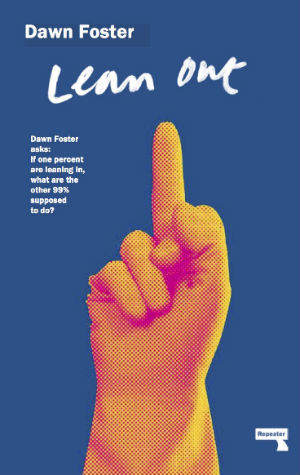
Foster’s Lean Out rejects the neoliberal feminism of the likes of Sheryl Sandberg and Clinton. Feminism must be about inequality, argues Lindsey German

Dawn Foster, Lean Out (Repeater Books 2016), 80pp.
What passes for feminism in the twenty-first century? There is something grotesque about a society where one of the richest women in the world can write a ‘self-help’ book exhorting the many millions of women who haven’t yet made it to lean in, to fit in, to think positively, to grow ambition, to roll with the punches, in order to achieve their place at the summit of corporate power. There is something even more grotesque in a female candidate for president of the US demanding support from women voters on the ground that to do anything else would be a betrayal of the feminism which was born in the US nearly fifty years ago. This despite the candidate’s record of backing for Wall Street, for austerity and for a war agenda which has hit women and children across the world particularly hard.
Yet these two women, the billionaire Facebook executive Sheryl Sandberg, and the US-Democrat Hillary Clinton, are held up as feminist icons. Women who have made it in a man’s world are feted as role models for the rest of us. Their back story can apply to all of us: of course women find it tough, of course they encounter terrible personal and institutional sexism, of course they have the main responsibility for childcare, of course they often feel unconfident and insecure. But they can overcome this through their own determination to succeed and to ensure that they are able to compete alongside men.
This is a variation of the old idea that women can solve their problems if only they put on a new frock, apply some lipstick and snap out of it. While many can testify to the temporary satisfaction resulting from such antidotes to oppression, snapping out of it isn’t really an option in the longer term.
Dawn Foster titles her timely and very useful book Lean Out as a riposte to Sandberg’s best-selling Lean In. She takes as her starting point not the dilemma of those in the 1% who are failing to make it into the inner sanctums of neoliberalism, but the 99% who are being shafted by them.
As Foster describes, the reality of most women’s lives is of grinding work, of the paid and unpaid variety. Women’s paid work, especially since the crisis of 2008, but dating before this with the advent of neoliberalism, is increasingly insecure, poorly valued and low paid. The more that women have been drawn into labour markets internationally, the worse their conditions have become. The gender pay gap exists in every country. Flexible working – heralded as freedom for working mums who can fit it in around childcare – has been turned to the advantage of employers.
This isn’t even to consider most unpaid work. The Office for National Statistics has estimated that such work in the household amounted to a value of more than £1 trillion in 2014 – over £38,000 per household. The majority of this is carried out by women, including caring for children, cooking and cleaning.
The pressure on women is immense. Whereas they work shorter hours than men in paid work, they work longer hours unpaid. The overall result is women being stuck in low paid jobs, unable to ease their domestic responsibilities through paying other people (usually women) to carry them out. As Foster says, this is very different from the Superwomen who subcontract all their domestic responsibilities to a range of servants and providers.
The argument that getting women in powerful positions helps all women is powerfully articulated, but as Foster points out, it isn’t true:
‘The central argument of 1% feminism – that getting women into high positions is better for everyone, because feminism “trickles down” and becomes the norm – works about as well as trickledown economics’ (p.45).
In fact, inequality is growing, with working-class people losing their share of wealth to the rich. And feminism as practised by women like Sandberg and Clinton is an equal-rights feminism which wants more women in top positions, but opposes fundamental changes to this inequality.
Which brings us back to the question of twenty-first-century feminism. Is it a symbol of equality which refuses to deal with economic inequality? Is it a lifestyle choice? What is its relationship to race and class? Dawn Foster is scathing about the ‘can you be a feminist and …’ school of thought. It isn’t about wearing high heels, shaving your armpits, which t-shirt you wear, and it can’t be reduced to forms of consumption. It has to be linked to activity to change the world. Foster argues for a working-class feminism which links the issue of women’s oppression to race and class, which has to support the fightback of women against austerity in all its forms, and which can be identified in a myriad of campaigns over housing, work, welfare provision, libraries and other services, and much more.
She argues that many women (and men) are fighting back:
‘rather than leaning in and trying to forge a path within structures that are so hostile to them, they’re leaning out and refusing to play the game anymore’ (p.80)
True enough; and not before time. We have a world to win.

